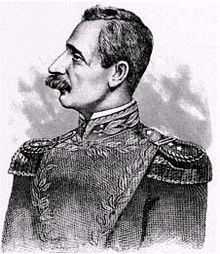Battle of Santa Inés
| Battle of Santa Inés | |||||||
|---|---|---|---|---|---|---|---|
| Part of the Federal War | |||||||
 Ezequiel Zamora, winner of Santa Inés | |||||||
| |||||||
| Belligerents | |||||||
|
|
| ||||||
| Commanders and leaders | |||||||
| Ezequiel Zamora | Pedro Estanislao Ramos | ||||||
| Strength | |||||||
| 3.400[1] Soldiers | 2.300[1] Soldiers | ||||||
| Casualties and losses | |||||||
| Unknown | Unknown | ||||||
The Battle of Santa Inés was a military confrontation occurred between 9 and 10 December 1859 during the federal war between federal forces under General Ezequiel Zamora and conservative government of General Pedro Estanislao Ramos, with rebels victory. located about 36 km southwest of Barinas, Venezuela
Background
Rebel Army
Once gathered his forces in Guanare, in mid-November 1859, generals Juan Crisóstomo Falcón and Ezequiel Zamora moved to Barinas, followed by the government army Western, whose commander gave the order to chase and beat. After his return movement, federals settled in Santa Inés, located about 36 km southwest of the city of Barinas, on the right bank of the Santo Domingo river. The federalist forces concentration was completed on December 9.
It was then that General Zamora took a defensive position and formulated a plan that consisted of a withdrawal, executed by the advanced, to attract the attacker to an area where it would be destroyed by a counterattack. Advanced, in addition to channel the action of the attackers must cause wear as possible by using the forces on successive three lines of trenches having a fourth line would be the final position and wherein the discharge receive attacker maximum combat power stroke force, composed of the reserve, increased by the forces from the preceding lines.
To comply with the above plan of attack, General Zamora made the following predictions: the village of La Palma was located advanced trench, which was led by Colonels Jesús Hernández Hernández y León; a little behind in a mill and a hut, was organized the first line under General Ignacio Antonio Ortiz; the second line commanded by General Rafael Pettit was about 900 meters back; the third line led by General Pedro Aranguren was formed at 800 meters above, at a crossroads; Finally the fourth line, 800 meters from the crossroads, consisted of the town; there was the book. According to the plan prepared by Zamora, upon presentation of the attacker in La Palma, the federalist troops would offer little resistance and redeploy to the first position; which would be delivered to the attacker, after some resistance; then the defenders occupy the second position; redeploy to where the third and there would just as in the previous line; remaining attackers at the mercy of the force of blow (reserve). The tactic of digging defensive trenches was performed for the first time in Amárica America.
The Battle
On December 8 the centralist army spent the night in the village of San Lorenzo, on the left bank of the river Santo Domingo. The next morning, the river level dropped and the centralist forces advanced towards La Palma, so federalist forces had to leave their position and go to the mill. Meanwhile, attackers armed camp in La Palma, in the assault had lost about 1,800 men.2
On December 10, the Conservatives resumed the attack, resulting in contact with the defenders of the mill (first position), which retreated after causing heavy casualties to the attacker. After the action against the first position, the attackers continued on the next position (second), which was taken after a bloody battle. After that the aim of the centralists was to conquer the third position, the strongest of which had been taken. To this end, General Ramos insisted combat thoroughly with artillery support, but the position could not be taken. Was further expected that there would be greater resistance before the attackers should fall under the action of forces in the village. Moreover, the attack carried out by Ramos, through an intricate entrenchment, efficiently combined with a barrage of fire, degenerated in complete failure for government forces, which had 900 losses . Convinced at last what fruitlessness of his company, General Ramos decided to order the withdrawal, which took place from midnight of that day. Finally, on December 11 at dawn, noting the absence of the attackers, Zamora decided it convenient for carrying out the relics of the centralist army and went in pursuit of the defeated
Consequences
General Ramos was seriously injured, had lost all their artillery and large number of horses, ordered the withdrawal to Barinas, which came less than 2,000 troops, being chased by rebels. The city was besieged on 23 December. After that Zamora left with 6,000 men from Barinas to Caracas taking places in his way. The decider will be the battle of Coplé the February 17, 1860.
See Also
References
- ↑ 1.0 1.1 "La Guerra Federal" (in Spanish). venezuelatuya.com. Retrieved 9 April 2014.